The Spatial Distribution Characteristics and Accessibility Analysis of Modern Commemorative Landscapes: A Case Study in Nanjing, China
Abstract
1. Introduction
2. Overview of the Research Subject
2.1. Urban Profile
2.2. Overview of Modern and Contemporary Commemorative Landscapes in Nanjing
3. Data and Methods
3.1. Data Acquisition and Processing Methods
3.2. Research Methods
3.2.1. Average Nearest Neighbor Index
3.2.2. Kernel Density Analysis
3.2.3. Spatial Accessibility Measurement Using the Cost Distance Method
3.2.4. Perceived Accessibility Measurement Using the Network Text Analysis Method
3.2.5. Entropy Weight Method
3.2.6. Geographical Detector Analysis
4. Results and Analysis
4.1. Spatial Distribution Characteristics of Modern Commemorative Landscapes in Nanjing
4.1.1. Spatial Distribution Patterns
4.1.2. Kernel Density Analysis
4.2. Comprehensive Accessibility Analysis of Modern Commemorative Landscapes in Nanjing
4.2.1. Spatial Accessibility Analysis
4.2.2. Perceived Accessibility Analysis
4.2.3. Comprehensive Accessibility Analysis
4.3. Accessibility Analysis of Different Types of Modern Commemorative Landscapes in Nanjing
4.3.1. Commemorative Facility Resources
4.3.2. Commemorative Ruins Resources
4.3.3. Eminent Historical Figure’s Burials
4.3.4. Integrated Memorials
4.4. Analysis of Influencing Factors on Accessibility of Modern Commemorative Landscapes in Nanjing
5. Discussion
5.1. Accessibility Differences Among Various Types of Commemorative Landscapes
5.2. Influencing Factors of Commemorative Landscape Accessibility
5.3. Optimization Recommendations
5.4. Research Limitations and Future Directions
6. Conclusions
Author Contributions
Funding
Institutional Review Board Statement
Informed Consent Statement
Data Availability Statement
Conflicts of Interest
References
- Qi, K. Meditations on Commemoration; China Architecture & Building Press: Beijing, China, 1996. (In Chinese) [Google Scholar]
- Ge, Y.; Lu, R. Evaluating the impact of monumental landscapes on population aggregation in Hongshan Culture. Asian Archaeol. 2025, 9, 97–108. [Google Scholar] [CrossRef]
- Tilden, F. Interpreting Our Heritage, 4th ed.; The University of North Carolina Press: Chapel Hill, NC, USA, 2009. [Google Scholar]
- Hu, H. Spatial Synergy Between Cultural Heritage and Metro Networks: A Case Study of Distribution Patterns and Value Assessment in Beijing. Sustainability 2025, 17, 1666. [Google Scholar] [CrossRef]
- Sert, J.L.; Léger, F.; Giedion, S. Nine Points on Monumentality. In Architecture Culture 1943–1968; Columbia University Press: New York, NY, USA, 1968; pp. 48–51. [Google Scholar]
- Kahn, L.I.; Latour, A. Louis I. Kahn: Writings, Lectures, Interviews; Rizzoli International Publications: New York, NY, USA, 1991. [Google Scholar]
- Rossi, A. Monumento a la Resistenza di Cuneo, 1962. DC PAPERS Rev. Crítica Teoría Arquitect. 2006, 15, 138–141. [Google Scholar]
- Liu, B.; Li, K. Preliminary study on design principles of memorial landscapes. Planners 2003, 2, 21–25. (In Chinese) [Google Scholar]
- Zhang, H.; Wang, X. Discussion on contemporary memorial landscape design. Chin. Landsc. Archit. 2010, 26, 38–42. (In Chinese) [Google Scholar]
- Feng, Y. Analysis of spatial characteristics of red memorial landscape design for event commemoration. Anhui Archit. 2021, 4, 26–28. (In Chinese) [Google Scholar] [CrossRef]
- Rofe, M.W. Memorial landscapes, recognition, and marginalisation: A critical assessment of Adelaide’s ‘cultural heart’. Landsc. Res. 2022, 48, 632–646. [Google Scholar] [CrossRef]
- Kelsch, P.J. Viewing the Landscape of the George Washington Memorial Parkway: A Cultural History of Scenic Resources and Landscape Ideology. Land 2022, 11, 1190. [Google Scholar] [CrossRef]
- van der Schriek, M. Landscape Biographies of Commemoration. Landsc. Res. 2018, 44, 99–111. [Google Scholar] [CrossRef]
- Rofe, M.W.; Ripmeester, M. Memorial Landscapes and Contestation: Destabilising Artefacts of Stability. Landsc. Res. 2023, 48, 609–614. [Google Scholar] [CrossRef]
- Różycki, S.; Michalski, M.; Kobielec, A. Use of Geoinformatics for the Digitization and Visualization of Sensitive Space in the Urban Landscape: A Case Study of the Gross-Rosen Sub-Camps Systems. Remote Sens. 2024, 16, 783. [Google Scholar] [CrossRef]
- Armstrong, L. Ms Memorial Maker: The Engagement of Female Memorial Makers with the Dominant Narrative of War in Australia’s War Memorial Landscape. Ph.D. Thesis, The Australian National University, Canberra, Australia, 2019. [Google Scholar]
- Attwa, Y.; Refaat, M.; Kandil, Y. A study of the relationship between contemporary memorial landscape and user perception. Ain Shams Eng. J. 2022, 13, 101527. [Google Scholar] [CrossRef]
- Gu, H. Thematic analysis of mausoleum landscape design: Comparative study of Ming Xiaoling Mausoleum, Sun Yat-sen Mausoleum and Yuhuatai Martyrs’ Cemetery. Hundred Sch. Arts 2010, 26 (Suppl. S1), 103–107. (In Chinese) [Google Scholar]
- Zhang, Q.; Zhang, Y. Research on spatial sequence of memorial landscape based on visual perception: A case study of Yuhuatai Martyrs’ Cemetery in Nanjing. Chin. Landsc. Archit. 2019, 35, 55–60. (In Chinese) [Google Scholar]
- Liu, B.; Jiang, S. Analysis of visual characteristics of memorial landscapes. Chin. Landsc. Archit. 2012, 28, 22–30. (In Chinese) [Google Scholar]
- David, B. Meaningful Pasts: Historical Narrative, Commemorative Landscapes, and Everyday Lives. Landsc. Hist. 2024, 45, 137–138. [Google Scholar] [CrossRef]
- Zhao, S.; Li, Q. Measurement of traffic accessibility and evaluation of tourism utilization potential of cultural heritage resources in Yunnan Province based on multi-source data. Arid. Land Resour. Environ. 2025, 39, 175–188. (In Chinese) [Google Scholar] [CrossRef]
- Hansen, W.G. How Accessibility Shapes Land Use. J. Am. Inst. Plan. 1959, 25, 73–76. [Google Scholar] [CrossRef]
- Du, H. Urban landscape accessibility evaluation model based on GIS and spatial analysis. Results Eng. 2025, 25, 103723. [Google Scholar] [CrossRef]
- Shang, N.; Cao, K. Study on the coupling between scenic spot accessibility and tourist flow in Xinjiang. World Reg. Stud. 2024, 33, 176–188. (In Chinese) [Google Scholar]
- Wang, W.; Cai, Y.; Xiong, X.; Xu, G. Evaluating Accessibility and Equity of Multi-Level Urban Public Sports Facilities at the Residential Neighborhood Scale. Buildings 2025, 15, 1640. [Google Scholar] [CrossRef]
- Lu, J.; Li, L.; Wang, W. Assessing accessibility and environmental equity in the context of sustained aging: Pathways for age-friendly urban park planning. Urban For. Urban Green. 2025, 108, 128768. [Google Scholar] [CrossRef]
- Meng, Y.; Xing, H.; Yuan, Y.; Wong, M.S.; Fan, K. Sensing urban poverty: From the perspective of human perception-based greenery and open-space landscapes. Comput. Environ. Urban Syst. 2020, 84, 101544. [Google Scholar] [CrossRef]
- Li, Z.; Liu, W.; Zhang, B. Spatial accessibility dynamics of urban parks in Nanjing, China: Implications for spatial equity. Open House Int. 2024, 49, 696–717. [Google Scholar] [CrossRef]
- Guo, N.; Wang, L. Analysis of kindergarten enrollment accessibility and influencing factors in Lanzhou City. Arid. Land Geogr. 2025, 48, 1043–1054. (In Chinese) [Google Scholar]
- Wang, Z.; Liu, Y.; Wang, T.; Tang, S.; Wu, X. Supply and demand analysis of urban thermal environments regulation services from an accessibility perspective: A coupled thermal risk and green space cooling assessment model. Urban Clim. 2025, 60, 102356. [Google Scholar] [CrossRef]
- Jalkanen, J.; Vierikko, K.; Kujala, H.; Kivistö, I.; Kohonen, I.; Lehtinen, P.; Toivonen, T.; Virtanen, E.; Moilanen, A. Identifying priority urban green areas for biodiversity conservation and equitable recreational accessibility using spatial prioritization. Landsc. Urban Plan. 2025, 259, 105356. [Google Scholar] [CrossRef]
- Fang, C.; Li, J.; Yang, B. Research on the protection of war landscape heritage from the perspective of collective memory: A case study of Nanjing Anti-Japanese War landscape heritage. Mod. Urban Res. 2017, 7, 22–30. (In Chinese) [Google Scholar]
- Meng, M. Differences between Chinese and Western memorial gardens and the trend of mutual integration. Chin. Landsc. Archit. 2007, 1, 61–65. (In Chinese) [Google Scholar]
- Li, J. Problems and protection suggestions of Anti-Japanese War sites in western China: The third paper of the series “Investigation and Research on Anti-Japanese War Sites in Western China”. Forum Chin. Cult. 2015, 12, 14–20+191. (In Chinese) [Google Scholar]
- Liu, L. Protection and Utilization of Modern Revolutionary Historical Sites. South. Cult. Relics 2005, 1, 118–122. (In Chinese) [Google Scholar]
- Savary, P.; Foltête, J.C.; Garnier, S. Cost distances and least cost paths respond differently to cost scenario variations: A sensitivity analysis of ecological connectivity modeling. Int. J. Geogr. Inf. Sci. 2022, 36, 1652–1676. [Google Scholar] [CrossRef]
- Li, Y. Measurement of facility service entity scope under CSPON background: Research on the all-position accessibility network model. Nat. Resour. Inform. 2025, 1, 72–80. (In Chinese) [Google Scholar]
- Tian, J.; Ming, Q.; Liu, A. Evaluation model of tourism accessibility based on time geography and its application in mountain tourist attractions. Hum. Geogr. 2023, 38, 181–191. (In Chinese) [Google Scholar] [CrossRef]
- Wang, K.; Xiao, Y.; Zhang, Z.; Zhiwei, L.Y. Research on tourism cultural scene types along the Grand Canal based on POI data. J. Geo-Inf. Sci. 2025, 27, 1738–1750. (In Chinese) [Google Scholar]
- Ji, X.; Xue, W.; Li, J.; Chen, F.; Li, W. Research on the measurement of Golden Week self-driving tour accessibility and influencing factors based on spatio-temporal utility method. J. Arid Land Res. Environ. 2024, 38, 197–208. (In Chinese) [Google Scholar] [CrossRef]
- Zou, Z.; Yun, Y.; Sun, J. Entropy method for determination of weight of evaluating indicators in fuzzy synthetic evaluation for water quality assessment. J. Environ. Sci. 2006, 18, 1020–1023. [Google Scholar] [CrossRef]
- Xiao, W.; Huang, E.; Li, C.; Li, H. Investigating the spatial distribution and influencing factors of traditional villages in Qiandongnan based on ArcGIS and geodetector. Sci. Rep. 2025, 15, 5786. [Google Scholar] [CrossRef]
- Li, W.; Xiao, J.; Zeng, P. Research on spatial distribution characteristics and influencing factors of cultural tourism resources along the Sichuan-Tibet route. J. Tibet Univ. Soc. Sci. Ed. 2025, 40, 203–209. (In Chinese) [Google Scholar] [CrossRef]
- Tan, X.; Liu, Z.; Shi, L.; Huang, X. Geospatial analysis of sports tourism resources in China’s urban clusters: A case study of the Sichuan-Chongqing region utilizing GIS and the geographic detector. Front. Sports Act. Living 2024, 6, 1496469. [Google Scholar] [CrossRef]
- Moreno, C.; Gall, C.; Woo, J.; Lee, D.; Bencekri, M. Assessing accessibility of cultural sites through the 15-minute city framework in Seoul. Int. J. Urban Sci. 2025, 29, 8–39. [Google Scholar] [CrossRef]
- Chen, X.; Zhang, H.; Yuan, Z. Contested memory amidst rapid urban transition: The cultural politics of urban regeneration in Guangzhou, China. Cities 2020, 102, 102755. [Google Scholar] [CrossRef]
- Zhou, H.; Ma, Y.; Fan, Y.; Ning, X. Spatial distribution and accessibility analysis of red tourism resources in Inner Mongolia. Arid. Land Geogr. 2023, 46, 814–822. (In Chinese) [Google Scholar]
- Pulido-Fernández, J.I.; Carrillo-Hidalgo, I.; López-Sánchez, Y.; Casado-Montilla, J. Assessing Social Carrying Capacity of Tourists in Protected Natural Areas. Curr. Issues Tour. 2025, 28, 1062–1078. [Google Scholar] [CrossRef]
- Neutens, T.; Schwanen, T. Equity of Urban Service Delivery: A Comparison of Different Accessibility Measures. Environ. Plan. A 2010, 42, 1613–1635. [Google Scholar] [CrossRef]
- Vale, D.; Lopes, A.S. Accessibility inequality across Europe: A comparison of 15-minute pedestrian accessibility in cities with 100,000 or more inhabitants. Urban Sustain. 2023, 3, 55. [Google Scholar] [CrossRef]
- Lee, G.; Hong, I. Measuring Spatial Accessibility in the Context of Spatial Disparity between Demand and Supply of Urban Park Service. Landsc. Urban Plan. 2013, 119, 85–90. [Google Scholar] [CrossRef]
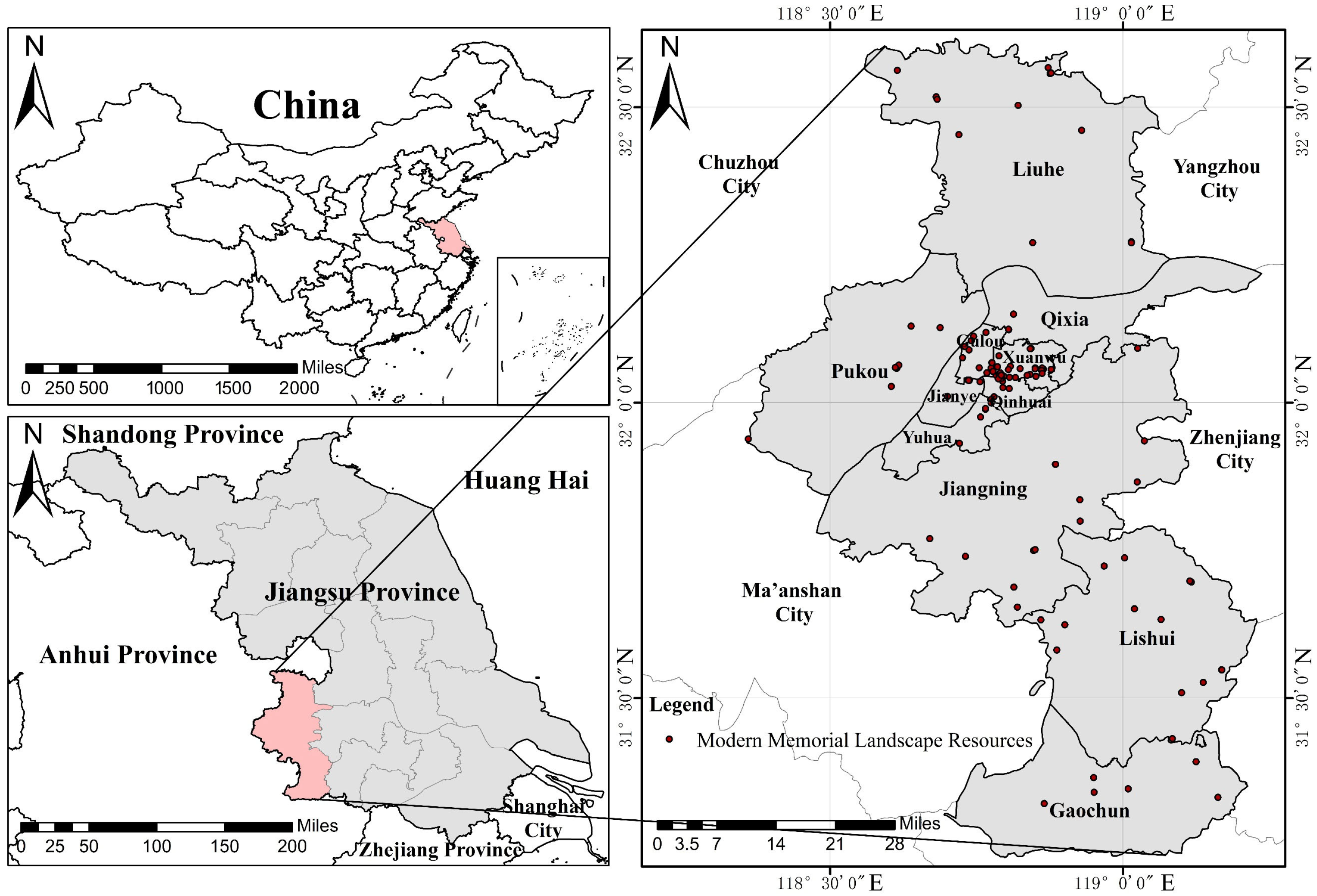
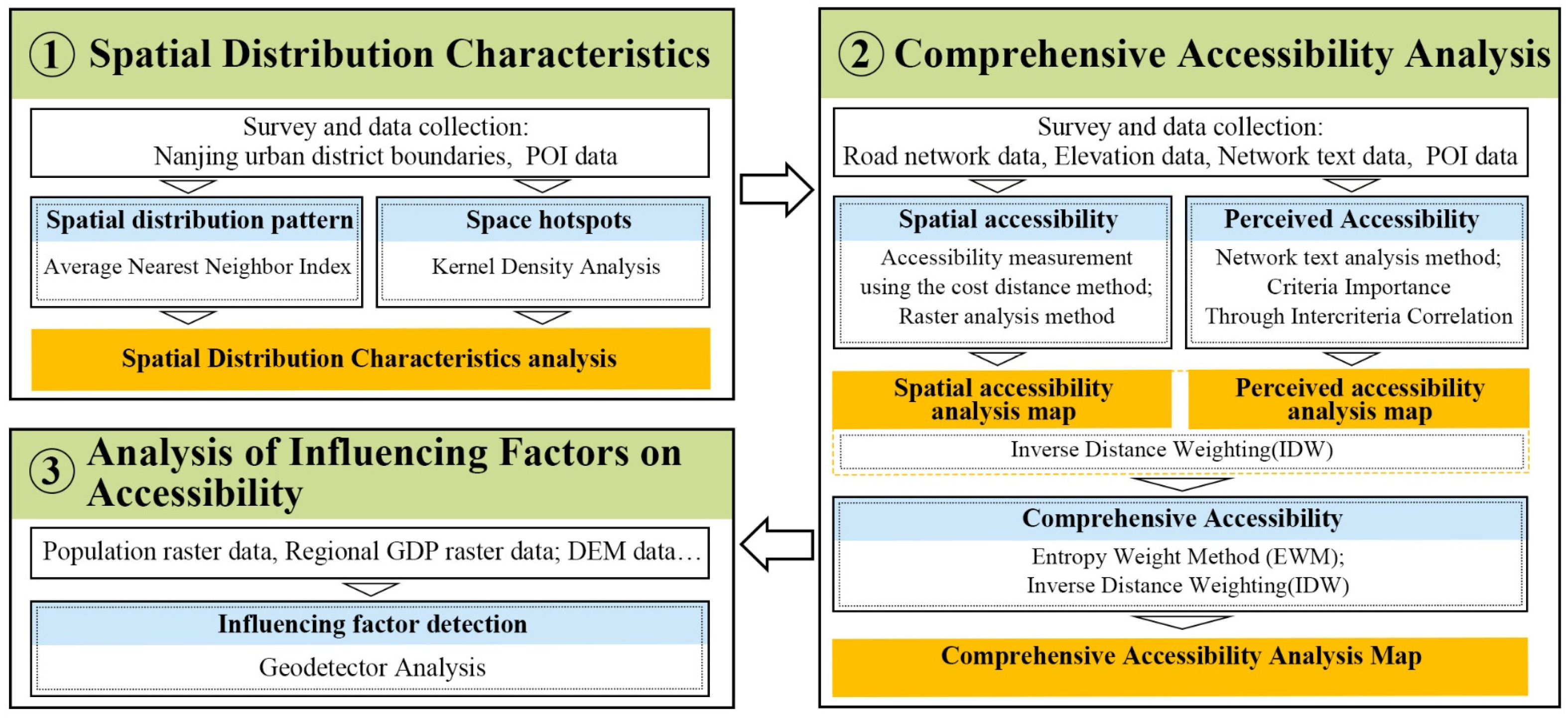
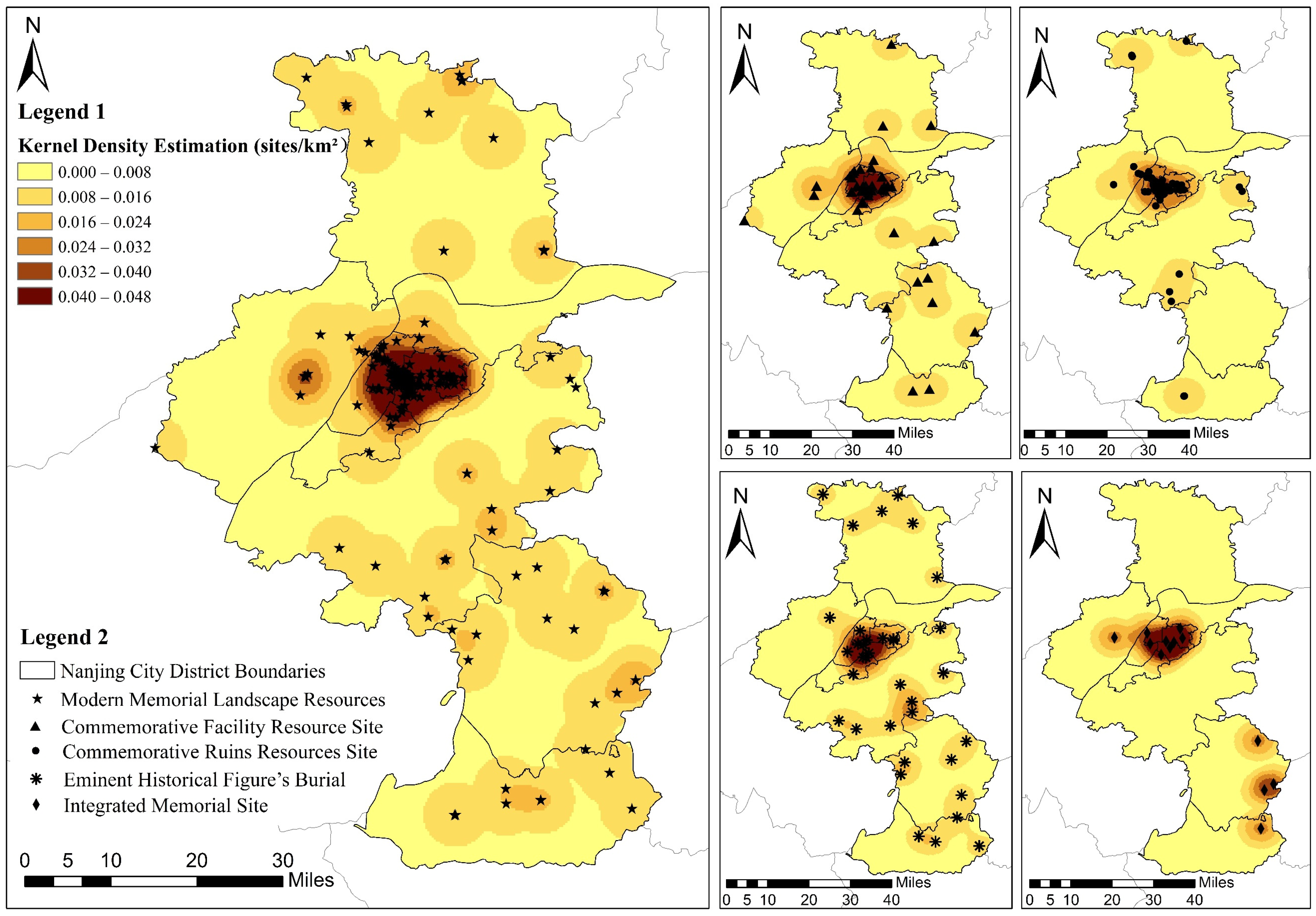
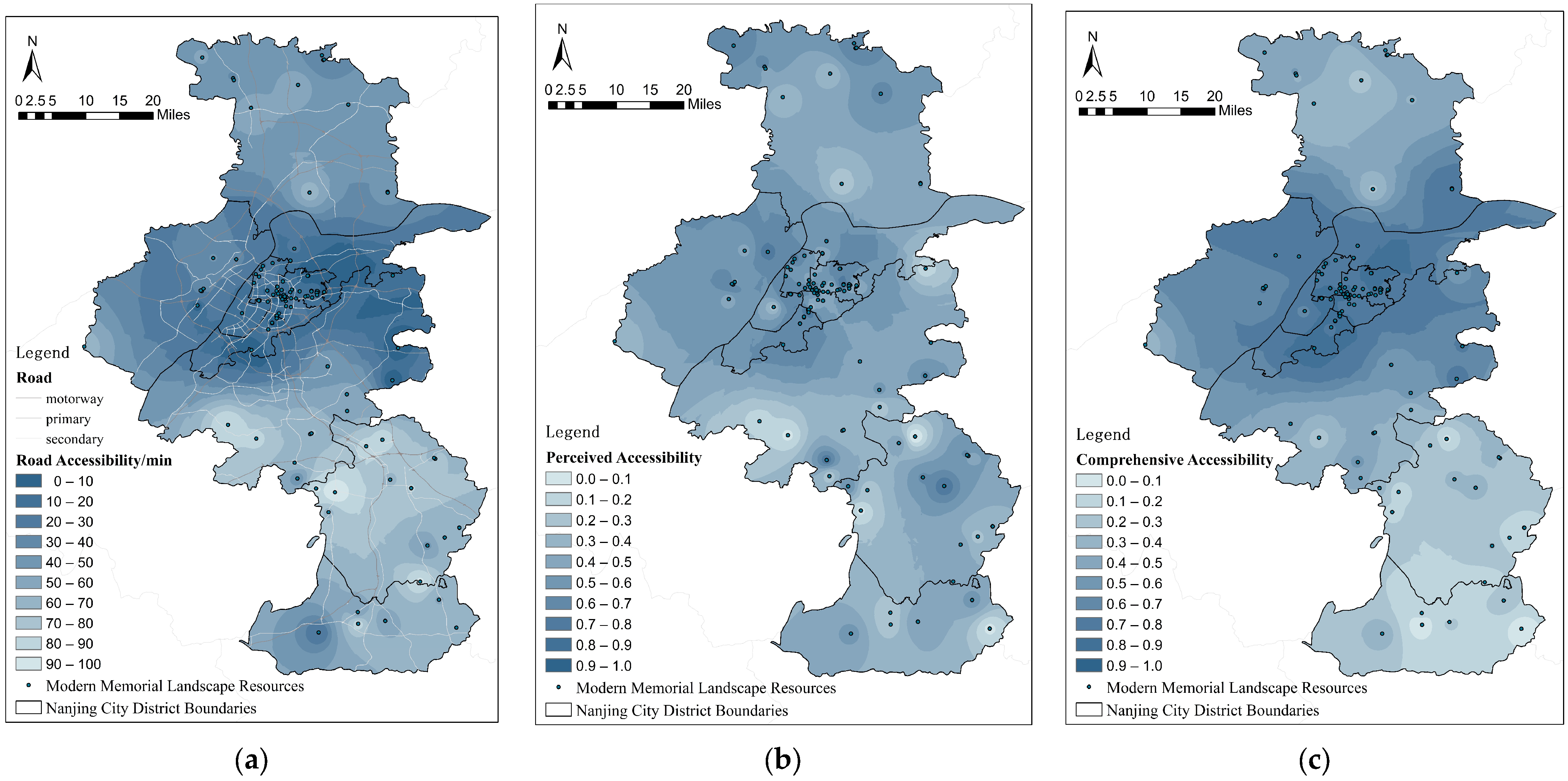
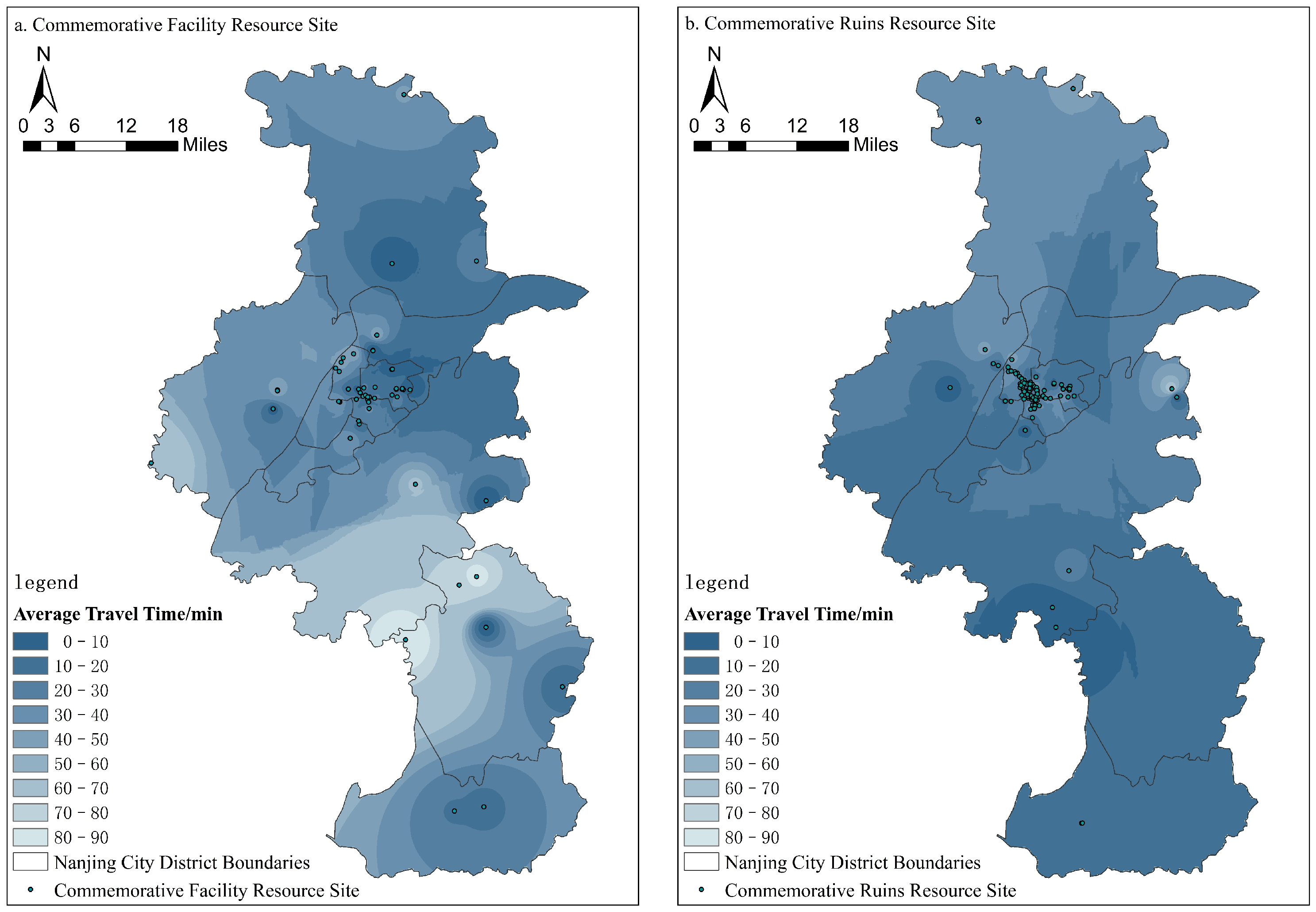
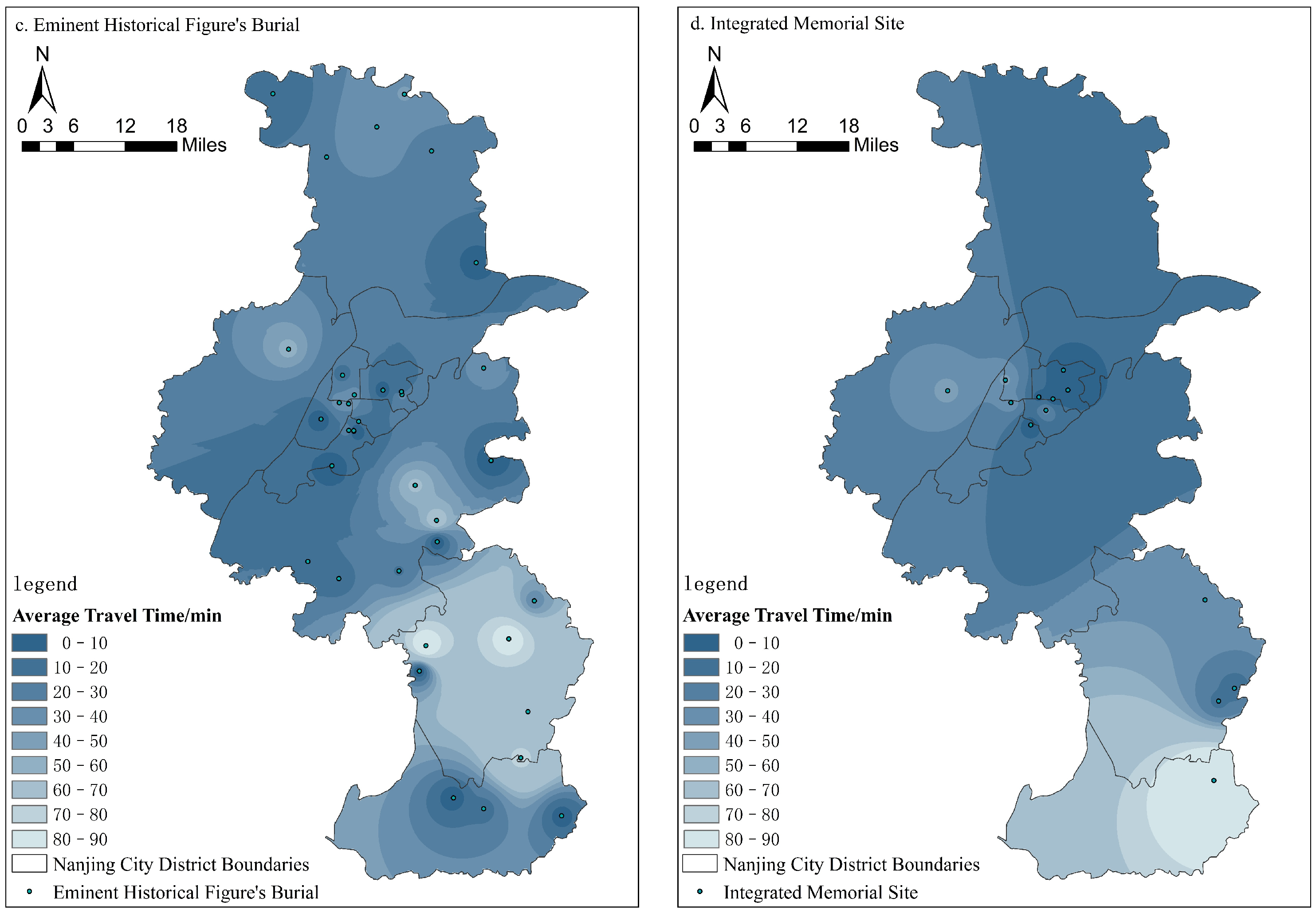
| Class | Coverage Types | Representative Landscape | Number of Sites | Proportion |
|---|---|---|---|---|
| Eminent Historical Figure’s Burial Site | Martyrs’ tombs, Martyrs’ cemeteries, soldiers’ cemeteries | Xitian Temple Cemetery Martyrs’ Cemetery, Yuntai Mountain Anti-Japanese Martyrs’ Cemetery, Zhuzhen Revolutionary Martyrs’ Cemetery, National Revolutionary Army Fallen Soldiers’ Cemetery | 36 | 29.03% |
| Commemorative Facility Resource Site | Memorial sites, monuments, memorial halls, memorials and former residences of famous people | The Square commemorating the 20 May Student Movement, the former residence of John Rabe, the Memorial Hall of the Chinese Communist Delegation in Meiyuan New Village, and the exhibition hall of the former site of the Nanjing Lijixiang Comfort House | 56 | 45.16% |
| Commemorative Ruins Resource Site | Memorial Site, Historic Site | The site of the 2 July strike of the railway workers in Liangpu, the site of the first police station of the New Fourth Army, and the site of the Pearl Bridge tragedy of the national student anti-Japanese patriotic movement | 20 | 16.13% |
| Integrated Memorial Site | Memorial scenic spots, large memorial halls, groups of memorial sites memorial park | Memorial Hall for the Victims of the Nanjing Massacre by Japanese Invading China, Yuhuatai Scenic Area, Memorial Hall for the Victory of Crossing the Yangtze River, Nanjing Anti-Japanese Aviation Martyrs Park, Zhongshan Mausoleum Scenic Area, and Xishe—Ligao County Anti-Japanese Democratic Government Old Site Group | 12 | 9.68% |
| Total | 124 |
| Name | Year | Type | Address | Longitude | Latitude | Level | Floor space |
|---|---|---|---|---|---|---|---|
| Yue Army Martyrs’ Cemetery | 1912 | Eminent Historical Figure’s Burial | 132 Shuiximen Street | 118.767674 | 32.039187 | Jiangsu Provincial Cultural Protection Unit | 377 m2 |
| The memorial hall of Meiyuan New Village of the CPC delegation | 1954 | Commemorative Facility Resource | 18-1 Hanfu Street | 118.808147 | 32.048913 | National key cultural protection units | 4600 m2 |
| The former site of the Central Army Military Academy | 1908 | Commemorative Ruins Resource | No. 3 Huangpu Road | 118.816028 | 32.059976 | National key cultural protection units | 23,499 m2 |
| Yuhuatai Scenic Area | 1949 | Integrated Memorial | 215 Yuhua Road | 118.786855 | 32.003382 | National key cultural protection units | 129.49 ha |
| Types of Memorial Landscapes | Value | -Value | Average Nearest Neighbor Index | Distribution Characteristics | Whether the Results are Significant |
|---|---|---|---|---|---|
| Commemorative Facility Resource | −4.30 | 0.00 | 0.66 | clustered | Yes |
| Commemorative Ruins Resource | −5.00 | 0.00 | 0.72 | clustered | No |
| Eminent Historical Figure’s Burial | 0.66 | 0.51 | 1.09 | dispersed | No |
| Integrated Memorial | 4.59 | 0.00 | 1.80 | dispersed | Yes |
| All | −12.32 | 0.00 | 0.48 | clustered | Yes |
| Item | Indicator Variability | Indicator Conflict | Information Content | Weight |
|---|---|---|---|---|
| Review Count of Commemorative Landscapes | 0.264 | 0.901 | 0.238 | 33.9964% |
| Rating of Commemorative Landscapes | 0.136 | 0.901 | 0.123 | 66.0036% |
| Attraction Name | Landscape Type | Result of Perceived Accessibility |
|---|---|---|
| Youzishan Martyrs Cemetery | Eminent Historical Figure’s Burials | 0.558 |
| “20 May” Student Movement Memorial Square | Commemorative Facility Resources | 0.389 |
| Former Headquarters Site of the New Fourth Army First Detachment | Commemorative Ruins Resources | 0.220 |
| Yuhuatai Scenic Area | Integrated Memorials | 0.755 |
| Item | Information Entropy e | Information Utility Value d | Weight Coefficient w |
|---|---|---|---|
| Spatial Accessibility | 0.9837 | 0.0163 | 46.0423% |
| Perceived Accessibility | 0.9753 | 0.0247 | 53.9577% |
| Attraction Name | Comprehensive Accessibility Evaluation Result | Spatial Characteristics | Perceptual Disparity |
|---|---|---|---|
| Youzishan Martyrs Cemetery | 0.399 | Surrounded by rural roads in Gaochun | Insufficient supporting facilities with historical significance |
| “20 May” Student Movement Memorial Square | 0.615 | Core urban area | Transportation hub with moderate public recognition |
| Former Headquarters Site of the New Fourth Army First Detachment | 0.427 | Node of district/county roads in Gaochun | Remote location with low visibility |
| Yuhuatai Scenic Area | 0.818 | Node of county roads in Jiangning | National 5A-level attraction with high review volume |
| X1-Attraction Kernel Density | X2-Regional Population Density | X3-Per Capita GDP | X4-Elevation | X5-Attraction Carrying Capacity | |
|---|---|---|---|---|---|
| statis | 0.297 | 0.519 | 0.197 | 0.389 | 0.653 |
| p-value | 0.000 | 0.000 | 0.002 | 0.000 | 0.000 |
| Factors | X1-Attraction Kernel Density | X2-Regional Population Density | X4-Per Capita GDP | X5-Elevation | X6-Attraction Carrying Capacity |
|---|---|---|---|---|---|
| X1-Attraction kernel density | 0.297 | ||||
| X2-Regional population density | 0.644 a | 0.519 | |||
| X3-Per capita GDP | 0.551 b | 0.636 a | 0.197 | ||
| X4-Elevation | 0.687 b | 0.760 a | 0.660 b | 0.389 | |
| X5-Attraction carrying capacity | 0.814 a | 0.913 a | 0.865 b | 0.867 a | 0.653 |
Disclaimer/Publisher’s Note: The statements, opinions and data contained in all publications are solely those of the individual author(s) and contributor(s) and not of MDPI and/or the editor(s). MDPI and/or the editor(s) disclaim responsibility for any injury to people or property resulting from any ideas, methods, instructions or products referred to in the content. |
© 2025 by the authors. Licensee MDPI, Basel, Switzerland. This article is an open access article distributed under the terms and conditions of the Creative Commons Attribution (CC BY) license (https://creativecommons.org/licenses/by/4.0/).
Share and Cite
Yan, Z.; Zheng, Z.; Feng, Z.; Zhong, S.; Gao, Y.; Sun, X. The Spatial Distribution Characteristics and Accessibility Analysis of Modern Commemorative Landscapes: A Case Study in Nanjing, China. Sustainability 2025, 17, 8355. https://doi.org/10.3390/su17188355
Yan Z, Zheng Z, Feng Z, Zhong S, Gao Y, Sun X. The Spatial Distribution Characteristics and Accessibility Analysis of Modern Commemorative Landscapes: A Case Study in Nanjing, China. Sustainability. 2025; 17(18):8355. https://doi.org/10.3390/su17188355
Chicago/Turabian StyleYan, Ziyang, Zhiyuan Zheng, Zun Feng, Suyu Zhong, Yuan Gao, and Xinwang Sun. 2025. "The Spatial Distribution Characteristics and Accessibility Analysis of Modern Commemorative Landscapes: A Case Study in Nanjing, China" Sustainability 17, no. 18: 8355. https://doi.org/10.3390/su17188355
APA StyleYan, Z., Zheng, Z., Feng, Z., Zhong, S., Gao, Y., & Sun, X. (2025). The Spatial Distribution Characteristics and Accessibility Analysis of Modern Commemorative Landscapes: A Case Study in Nanjing, China. Sustainability, 17(18), 8355. https://doi.org/10.3390/su17188355






